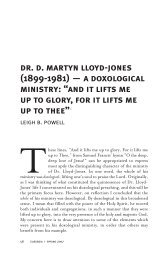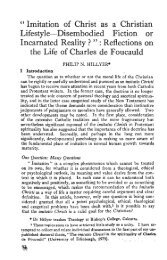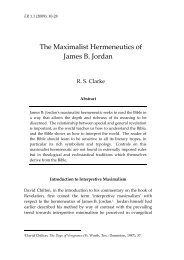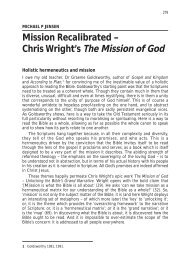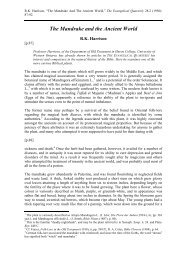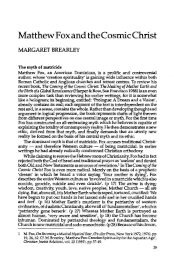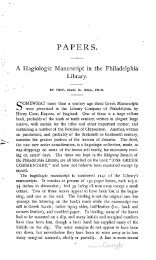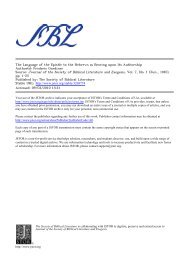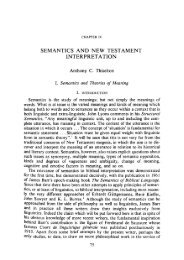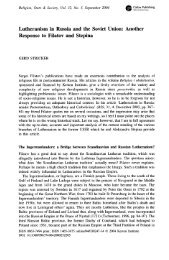Ancient Orient and Old Testament - BiblicalStudies.org.uk
Ancient Orient and Old Testament - BiblicalStudies.org.uk
Ancient Orient and Old Testament - BiblicalStudies.org.uk
You also want an ePaper? Increase the reach of your titles
YUMPU automatically turns print PDFs into web optimized ePapers that Google loves.
K.A. Kitchen, <strong>Ancient</strong> <strong>Orient</strong> <strong>and</strong> <strong>Old</strong> <strong>Testament</strong>. London: Inter-Varsity Press, 1966. Hbk. pp.191.<br />
to doubt the Hebrew text at this point, <strong>and</strong> the possible sites of Pi-Ramesse - Tanis 7 or Qantir, 8 or<br />
both 9 -<br />
[p.59]<br />
were original foundations by Sethos I <strong>and</strong> Ramesses II, 10 so that the Exodus can hardly be dated<br />
in the preceding Eighteenth Dynasty as was once thought by some scholars, 11 who argued that the<br />
name Ra’amses was original neither in the Hebrew text nor in the name of the city on Egyptian<br />
monuments.<br />
Secondly, the so-called ‘Israel Stela’ commemorates a victory of Merenptah over the Libyans in<br />
his fifth year (c. 1220 BC), <strong>and</strong> mentions places <strong>and</strong> peoples in Syria-Palestine claimed as<br />
subdued by Merenptah - including Israel. This clearly suggests that Israel was already in Western<br />
Palestine by 1220 BC. 12 Some scholars, however, have doubted whether Merenment<br />
of Ex. 1:11, Pithom <strong>and</strong> Ra‘amses by D. B. Redford, VT 13 (1963), pp. 401-418, is misleading <strong>and</strong> almost<br />
worthless; cf. the able refutation <strong>and</strong> corrections given by W. Helck, VT 15 (1965), pp. 35 - 48.<br />
6 A combination of astronomical (lunar) <strong>and</strong> historical data makes it certain that the accession of Ramesses II<br />
occurred either in 1290 BC or fourteen years earlier in 1304 BC (cf. R. A. Parker, JNES 16 (1957), pp. 42 - 43) .<br />
The ‘high date’ 1304 BC is advocated by Rowton (JCS 13 (1959), pp. 1-11; JNES 19 (1960), pp. 15-22), while<br />
the more commonly accepted ‘low date’ 1290 BC is methodically defended by E. Hornung, Untersuchungen<br />
zur Chronologie <strong>and</strong> Geschichte des Neuen Reiches, 1964. In point of fact, the available evidence is still<br />
indecisive; see my review of Hornung’s valuable monograph in Chronique d’ Égypte 40/Fasc. 80 (1965), pp.<br />
310-322. Hence I retain, dates based on 1290 for the accession of Ramesses II merely provisionally; 1304 dates<br />
must also be reckoned with at present.<br />
7 P. Montet, RB 39 (1930), pp. 5-28; Géographie de l’Égypte ancienne, I, 1957, pp. 194-197; Revue<br />
Archéologique, 1958-1, pp. 1-20; L’ Égypte et la Bible, I 1959, pp. 54-55; H. Kees, Tanis, 1942, pp. 150-155.<br />
8 M. Hamza, ASAE 30 (1930), pp. 31-68 (esp. 64-68); L. Habachi, ASAE 52 (1954), pp. 443-447, 500, 510-514,<br />
545-559. Also W. C. Hayes, Glazed Tiles from a Palace of Ramesses II at Kantir, 1937, pp. 5-8; <strong>and</strong> Scepter of<br />
Egypt, 11, 1959, pp. 332 - 333, 334-339 Good discussion of pros <strong>and</strong> cons (without final verdict) is B. Couroyer,<br />
RB 53 (1946), pp. 75 - 98.<br />
9 Taking Pi- Ramessē in the broad (<strong>and</strong> administratively-correct) sense of ‘Estate (not “House”) of Ramesses’,<br />
including Tanis <strong>and</strong> Qantir in one domain of scattered settlements <strong>and</strong> institutions. See Gardiner, Anc. Eg.<br />
Onomastica, II, p. 1 75 * ; C. F. Nims, JNES 9 (1950), p. 261; A. Alt, FS Zucker, 1954, pp. 7 - 8 (=KS, III, 1959, pp.<br />
181-182) ; H. Kees, <strong>Ancient</strong> Egypt, A Cultural Topography, 1961, p. 201; W. Helck, VT 15 (1965), p. 41. This<br />
view is probably the most realistic at present.<br />
10 Cf. Montet (note 7 above) <strong>and</strong> Habachi (note 8 above).<br />
11 As the official building-works of the Ramesside kings in the E. Delta are usually found to be the first original<br />
works there since the Hyksos period four centuries earlier, they are not mere usurpations of Eighteenth Dynasty<br />
structures as is sometimes suggested by advocates of a fifteenthcentury date for the Exodus (e.g., J. W. Jack,<br />
The Date of the Exodus, 1925, pp. 22-32). This can be seen from (e.g.) the frequency of genuine Ramesside (<strong>and</strong><br />
absence of Eighteenth Dynasty) monuments in Lower Egypt in B. Porter <strong>and</strong> R. L. B. Moss, Topographical<br />
Bibliography of <strong>Ancient</strong> Egyptian Hieroglyphic Texts (etc.), IV, 1934, pp. 1-68 (esp. 1, 6-44, 52-58); so far, only<br />
Bubastis has both (cf. L. Habachi, Tell Basta, 1957), <strong>and</strong> this city is no c<strong>and</strong>idate for identification with<br />
Ra‘amses/Pi-Ramessē.<br />
12 The equation of the name Ysr’r (Egyptian for Ysr’l) on the Merenptah stela with Hebrew Israel is universally<br />
recognized by all competent philologists in Egyptian <strong>and</strong> Semitic, <strong>and</strong> likewise with the Israelites who left<br />
Egypt at the Exodus explicitly <strong>and</strong> uniformly commemorated in the Pentateuch <strong>and</strong> other OT writings. Yet<br />
Eissfeldt, without evidence, would claim that Ysr’l is ambiguous because it could well be for Jezreel (CAH 2 , II:<br />
26a (Palestine in the Nineteenth Dynasty... ), 1965, p. 14). This is an incredible ‘howler’; Heb. z appears as d±± or t±<br />
in Egyptian, not s (cf. Helck, Beziehungen, pp. 589, 554:18), <strong>and</strong> Ysr’l wholly lacks the ‘ayin of Jezre’‘el! Noth’s<br />
idea that Ysr’l could be some earlier entity than OT Israel bearing the same name (History of Israel 2 , 1960, p.




